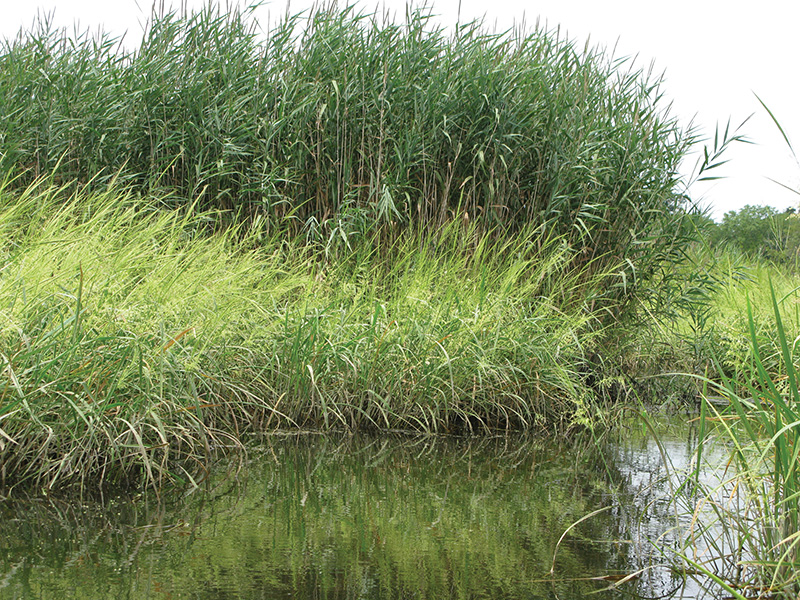

The non-native and invasive Phragmites australis shown dwarfing native wild rice, an important wildlife food.
This familiar estuary plant has an interesting history that dates back over 10,000 years, with a twist at the turn of the 19th century.
Those familiar cinnamon plumes, waving in unison from their towering vantage point above our marshes and sand dunes, were not always so abundant, or robust. In fact, there was a time when this plant was barely noticeable as a member of our native marsh plant community.
Phragmites is a member of the grass family and is thought to be one of the most widespread flowering plants on Earth, occurring on every continent except Antarctica. The word Phragmites comes from the Greek word phragma, appropriately meaning fence. Within the estuary, this plant is most noticeable in our brackish and freshwater tidal marshes although it has also made itself at home along lakes, waterways, and roadsides.
In Europe, Phragmites is grown commercially and used for thatched roofs, as food for livestock and in cellulose production. Ironically in parts of Europe where it is declining, there is concern about its long-term survivability.
But locally, this all-too-common plant is a reviled invasive species and the subject of numerous and ongoing eradication efforts. It will, therefore, come as a surprise to many to hear that there is a local, native, and non-invasive Phragmites growing in the estuary region alongside its more familiar and troublesome relative. And therein lies the story of this much-maligned plant that takes its place among a number of others that conservation land managers and waterfront homeowners alike would rather see done away with.
To be clear, the towering plant we are familiar with and is so abundant in the estuary, is not the native Phragmites. Our native Phragmites survives locally as small remnant populations, and although there are many similarities between the native and non-native plant [see box], their footprints are very different. The native Phragmites is significantly more diminutive: it is shorter and occurs in low densities, comingling with other native marsh plants, much the way scientists suggest it has done historically for thousands of years. Knowing how we ended up with two Phragmites, and how one has dominated at the expense of the other, has been the subject of ongoing scientific inquiry.
The story begins—at least locally—in the late 1970s. Researchers from Connecticut College extracted cores of peat several meters deep from Connecticut River estuary marshes that revealed, among other things, the preserved remains of Phragmites plants. Radiocarbon dating disclosed that they were growing between 3,000 to 4,000 years before present, suggesting that these plants were native (i.e. established before the arrival of Europeans). By 1990 Phragmites in the northeast had shifted from being described as “not common” or “occasional” as a tidal marsh component to a troublesome and widespread “nuisance species.” What happened?
Answers to that question have been gradually assembled by the scientific community—many of them from local universities—over the ensuing years. But in 2003 research published out of Yale University provided a compelling answer. In an effort to explain the explosion of this plant in our local marshes, and, in fact, throughout the northeast, samples of Phragmites were assembled from across the globe, taken from live plants as well as herbarium specimens spanning the years ranging from 1852 to 2001. With the use of genetic DNA sequencing, it was determined that there are, in fact, eleven native Phragmites lineages that are unique to the North American continent and are distinguished from all other Phragmites worldwide.
Today a single genetically-distinct Phragmites dominates the Atlantic coast of North America. It is the result of one continent’s lineage of Phragmites canoodling with another: based on its genetics, the interloper likely originated in Europe and Asia. The seeds of this union probably arrived at any number of east coast ports early in the 19th century, used as packaging for imported china, or as anticipated fodder for livestock. Or perhaps its humble beginnings were the result of seeds stuck in the hem of a dress, or the seam of pant trousers.
Regardless of the vector, its introduction resulted in a hybrid between the North American continent’s native Phragmites and a Eurasian relative: a new plant that “conferred competitive advantages” over both of its parents. That plant—Phragmites australis—the invasive, non-native Common Reed, has “virtually eliminated native lineages” in our part of the country. The “native” Phragmites that remains in the Estuary—and is believed to have been here for at least 10,000 years—is now referred to as American Reed, Phragmites australis subspecies americanus. This plant is found sporadically throughout New England and is listed as a plant of special concern in the state of Connecticut.
The invasive Phragmites—Common Reed—is still largely limited to the Atlantic Coast, although it has begun to appear in the Midwest and most notably has an established presence in the Great Lakes.
What bestows success?
Why the Common Reed dominates is the signature of all the invasive organisms that we increasingly deal with: it is highly competitive. This plant has multiple contingencies for success; virtually everything about it is supersized. Unlike its native counterpart, the American Reed, this perennial grass can reach heights of 20 feet, producing stout, erect, and densely packed stems that persist through the winter and can remain standing for over two years. It emerges earlier, produces greater biomass, and activates dormant roots more rapidly than its native counterpart. It is also shade tolerant, using its large, horizontal leaves to efficiently compete for available light. Growth rates for this plant have been recorded at up to 33 feet in a single growing season.
All Phragmites—that group, or genus, of plants that share common attributes, reproduce by means of underground roots called rhizomes. As an added measure, they also employ stolons—horizontal surface roots that enable new plants to establish via runners, even across the surface of water bodies. In Minnesota, an entire stand of this plant broke off from an existing population in a storm and regenerated close to a mile from its original location, a testament to the durability and tenacity of this plant’s root system.
The success of the Common Reed has another collaborator: the ongoing manipulation of coastal areas and wetlands by humans. Numerous scientific papers and management documents cite the correlation between the establishment and spread of Phragmites to nutrient inputs (such as sewage and fertilizer use) and exposed soil due to developed shorelines: roads, railroad beds, agriculture, and even mosquito ditches. Cleared edges provide opportunities for this plant to spread into interior marsh areas; heavy machinery can even unwittingly spread roots to new sites.
What can be Done?
The Common Reed has led more than one scientist to conclude that its eradication is unlikely. But that does not mean that it cannot be managed, and there have been successful efforts to eliminate smaller-scale populations. The state of Connecticut has been controlling Phragmites since 1997 with the objective to reduce the extent of stands in brackish and freshwater tidal wetlands. Their methods include restoring the flow of salt water into previously impounded or restricted areas, particularly along the coast, by replacing undersized culverts and tide gates, and using a combination of herbicides and mowing for three successive years on state-owned marshland. Private contractors have also recognized the opportunity to provide control efforts, although strict guidelines and licensing are required to work with herbicides.
Effective control requires targeting the right portion and at the right time in the population’s life cycle, notably directed to the rhizomes in the late fall when the plant has put most of its energy underground. Multiple stressors are most effective, over a minimum of three years, and follow-up management is essential. Scientists and practitioners continue to investigate the potential for finding natural or carefully introduced, usually insect, predators to control this plant biologically. Although there are over 25 insect herbivores that feed on Phragmites in North America, none have as yet emerged as serious candidates for widespread control.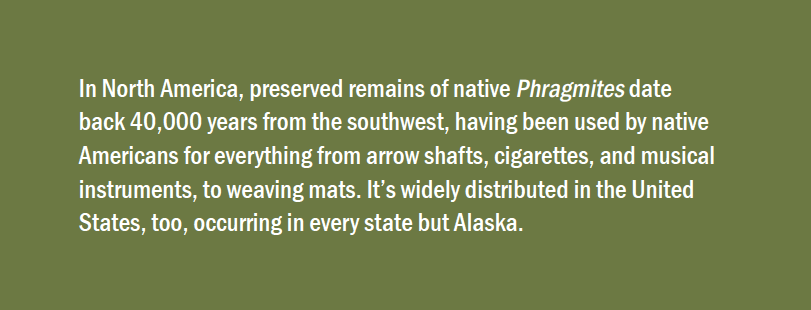
Scientists cite a number of serious threats from the spread of the Common Reed, among them the loss of ecological diversity; altered soil properties and sedimentation rates; the loss of bird, fish, and turtle habitat; and altered food webs. The loss of nesting habitat is especially critical for state-listed species such as the Seaside Sparrow, Saltmarsh Sparrow, and Willet, whose numbers continue to decline.
Some scientists cite the ability of the Common Reed to lock up nutrients and alter marsh surface elevations as the greatest long-term threat from this plant. By aggressively taking up and conserving (because of its slow decomposition rate) critical nutrients from the soil and flooding tidal water around it, this plant robs, or alters the timing of, essential building blocks from its competitors. And because it accumulates debris by breaking down slowly, sediment is trapped during flooding episodes as well, incrementally building up the marsh surface. This plant essentially becomes an “ecosystem engineer” that can reset the trajectory of an entire marsh, a result that is not easily reversed. Although not unique to the Common Reed—Japanese knotweed and kudzu also employ this strategy—these “legacy effects” are troubling, even if they are not yet fully understood.
Despite the sound of it, marshes containing Common Reed are not ecologically useless. Some waterfowl and songbirds eat the seeds, various birds exploit the insect scales that commonly are found on the leaves, and muskrats eat the rhizomes and stems. The density of Phragmites stands provide shade and cover that is used by red-winged black birds, Virginia rail, and white-tailed deer. One seven-year study in Delaware observed that ten species of wading birds nested in Common Reed. And the Connecticut River estuary has ample evidence of the importance of this plant for roosting at the annual pre-migration congregation of tree swallows on Goose Island.
Perhaps we have just neglected to harness the below-ground capacity of the Common Reed to wrest nitrogen, biological oxygen demand, and total suspended solids for primary municipal wastewaters, or to employ those densely packed rhizomes to prevent soil erosion. In other parts of the world, such as the Danube River delta in Romania, Phragmites is harvested for pulp production.
But even employing Common Reed for new tasks will not solve the dangers it imposes to our ecologically productive tidal marshes. We may have to settle for ongoing efforts to address manageable locations of this species, with vigilance, and quickly addressing new and spreading populations. A warming climate and the prospects of sea-level rise could favor this plant—which, by trapping sediment, may be able to keep up with rising waters. So much for the meek inheriting the marsh.
Judy Preston is a local ecologist active in the Connecticut River Estuary.
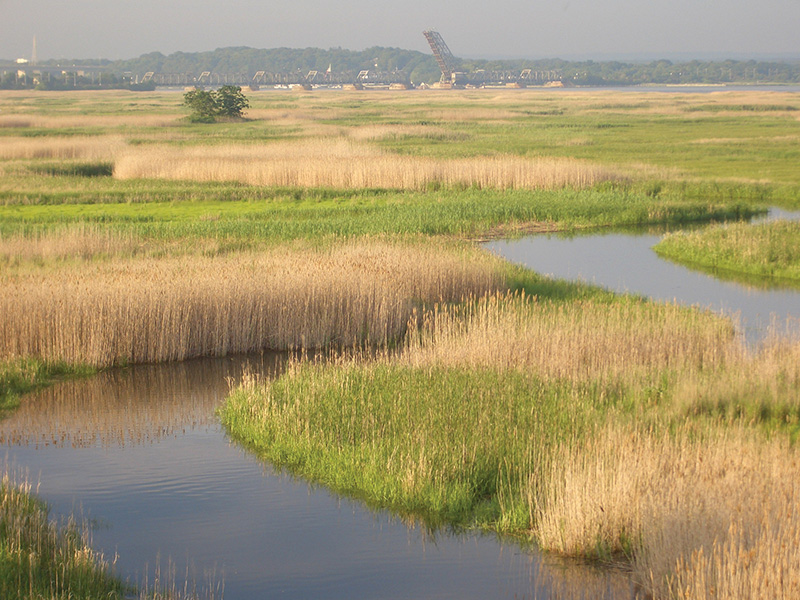
Common Reed (non-native, invasive)
Phragmites australis
Robust perennial grass growing 6–15 feet; easily recognized by plume-like flower; foliage bluish green; stems erect, densely packed, remain standing with leaf sheaths attached through winter
American Reed (native)
Phragmites australis subspecies americanus
Up to two meters tall; plume flower more open and smaller; foliage yellowish green; stems sparsely scattered, smooth, shiny and reddish-brown, may have black spots (caused by a native fungus); lower leaf sheaths drop after growing season.
Source: The CT Agricultural Experiment Station
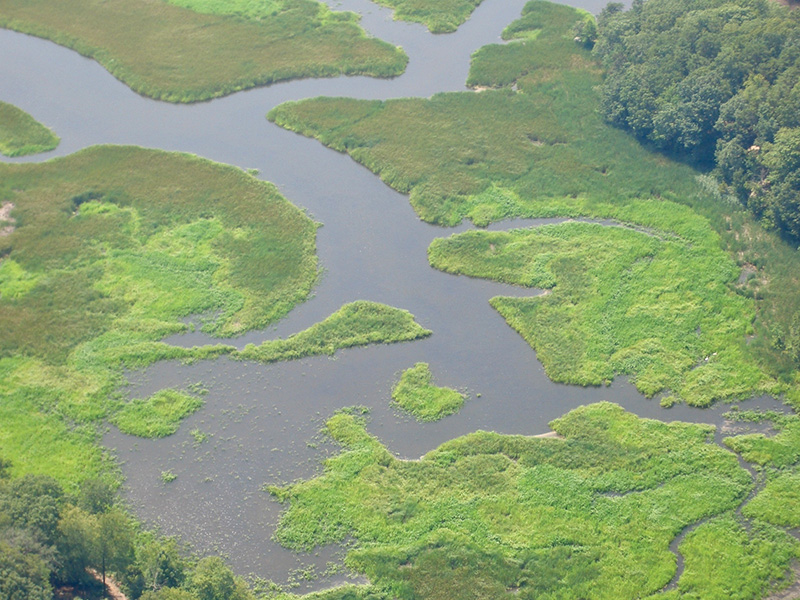
Researchers have noted that some invasive species are not only competitive enough to invade a system whether or not there is a disturbance, but also that these highly competitive invasives are able to modify ecosystem structure, energy flows, and nutrient pools and fluxes
. Phragmites australis, an invasive reed grass, is one such species.” (Chambers 1997, Gordon 1998, Ewel et al. 1999, Windham and Lathrop 1999, Meyerson et al. 2000, and others)
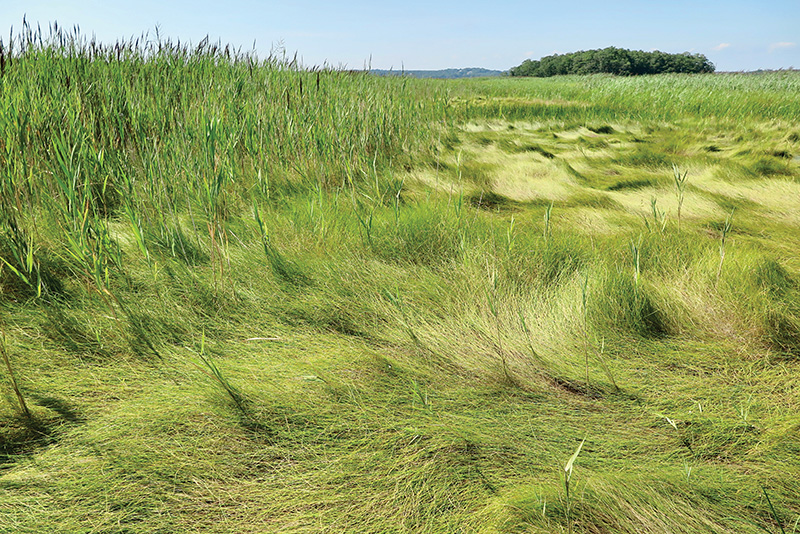
Recommended Resources
A Guide to the Control and Management of Invasive Phragmites. Great Lakes Phragmites Collaborative: www.greatlakesphragmites.net/pamf/about-pamf/
Phragmites – Distinguishing the Native from the Non-native. The Connecticut Agricultural Experiment Station (CAES)
https://portal.ct.gov/-/media/CAES/DOCUMENTS/Publications/Brochures/PhragmitesHandoutF2pdf.pdf?la=en
Controlling Invasive Phragmites in Connecticut Wetlands.
https://portal.ct.gov/-/media/DEEP/wildlife/pdf_files/habitat/PhragControlpdf.pdf?la=en

